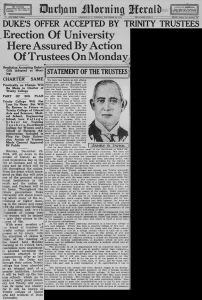Primary Source Set
Tobacco, Part 2: Culture & Influence
This part of the tobacco series explores the way that the tobacco industry maintained its influence even as the dangers of tobacco use became clear. Through advertisements, photographs, scrapbook entries, and video, this set of primary sources shows some of the cultural importance of tobacco in North Carolina.
Time Period
20th century
Grade Level
8 – 12
Transcript
"Duke's Offer Accepted by Trinity Trustees," the Durham Morning Herald [December 30, 1924]
More than a decade after he formally left the American Tobacco Company, James B. Duke decided to purchase Trinity College in Durham and rename it for himself. Today, the school is still known as Duke University.
Contributed to DigitalNC by University of North Carolina at Chapel Hill
Durham, N.C. (Durham County)
Background
For decades, tobacco has been one of the most important products in North Carolina’s economy and culture. This was especially true in the century between 1880 and 1980, when several major tobacco companies formed the base of North Carolina’s economy. Tobacco generated so much money in the state that it touched the lives of every North Carolinian, either directly or indirectly, through their jobs, their schools, and the cities they lived in.
Tobacco is a plant that is used to make cigarettes, cigars, dip, and other products (usually for smoking). Nicotine is a chemical in tobacco leaves that can make a tobacco user feel relaxed, but it is also highly addictive. Tobacco products often lead to several grave health consequences, including cancer, heart disease, strokes, and lung disease, plus increased risk for several other illnesses. Even though smoking was known to be dangerous in the 1950s, tobacco companies used marketing and advertising to distort public perception and continue their business for decades longer. It was especially difficult for North Carolinians to condemn the tobacco industry, even in the 1980s and ‘90s, because of the tremendous influence it had in the state. Since then, the decline of the tobacco industry has led to population and job decreases, particularly in the eastern part of the state. This major shift in North Carolina’s economy led to some of the prominent agricultural industries of today, including hog, chicken, and soybean farming.
This influence of tobacco extended to the culture of North Carolina as well. Generations of farmers developed traditions around the planting, harvesting, drying, and auctioning of tobacco plants. Tobacco companies brought new technology into their factories, and workers in those factories advanced civil rights and labor protections. Cigarette advertisements shaped the marketing industry, even appearing in high school and college newspapers. Money from tobacco was used to build up rural communities, cities, and schools. Some of the biggest names in tobacco are still recognizable today, including the Duke family in Durham (owners of the American Tobacco Company), William T. Blackwell and Julian S. Carr (two partners of Bull Durham tobacco), and Richard J. Reynolds of Winston-Salem (proprietor of R. J. Reynolds Tobacco Company).
Discussion Questions
Look at the photos from tobacco parades: the Tobacco Queens contest and the Chesterfield float. What do you think about them? Have you seen anything like this before? Have other industries replaced tobacco in these kinds of public spaces?
Tobacco companies focused on advertising to distract the public from the risks of smoking. What strategies do these two ads use to get people to buy cigarettes? Do you find these ads convincing? Have you seen similar ads (maybe for other products) today?
The tobacco industry created a few rich and powerful families, including the Duke family and the Reynolds family. Looking at the photo of the Babcock children (Reynolds’ grandchildren), what do you think life was like for these families? What impacts did they have on our state?
Consider some of the landmarks that still carry the legacies of the major tobacco families today. Some examples include Duke University, Wake Forest University (financially supported by the Reynolds family), and the town of Carrboro (named for Julian S. Carr of Bull Durham Tobacco). Why do you think tobacco magnates spent so much money on landmarks and schools?
Throughout the 20th century, tobacco companies were the subject of anti-trust lawsuits, which found that a few major companies were monopolizing the whole industry. How does this letter from L.W. Davis to R.J. Reynolds illustrate the relationships between tobacco executives?
Tobacco brought a lot of wealth, jobs, and development to North Carolina, but it also sold products that were dangerous to people’s health. Do you think the influence of tobacco in the state was overall positive, negative, or some of both? Why?
This primary source set was compiled by Sophie Hollis.
Updated January 2025
